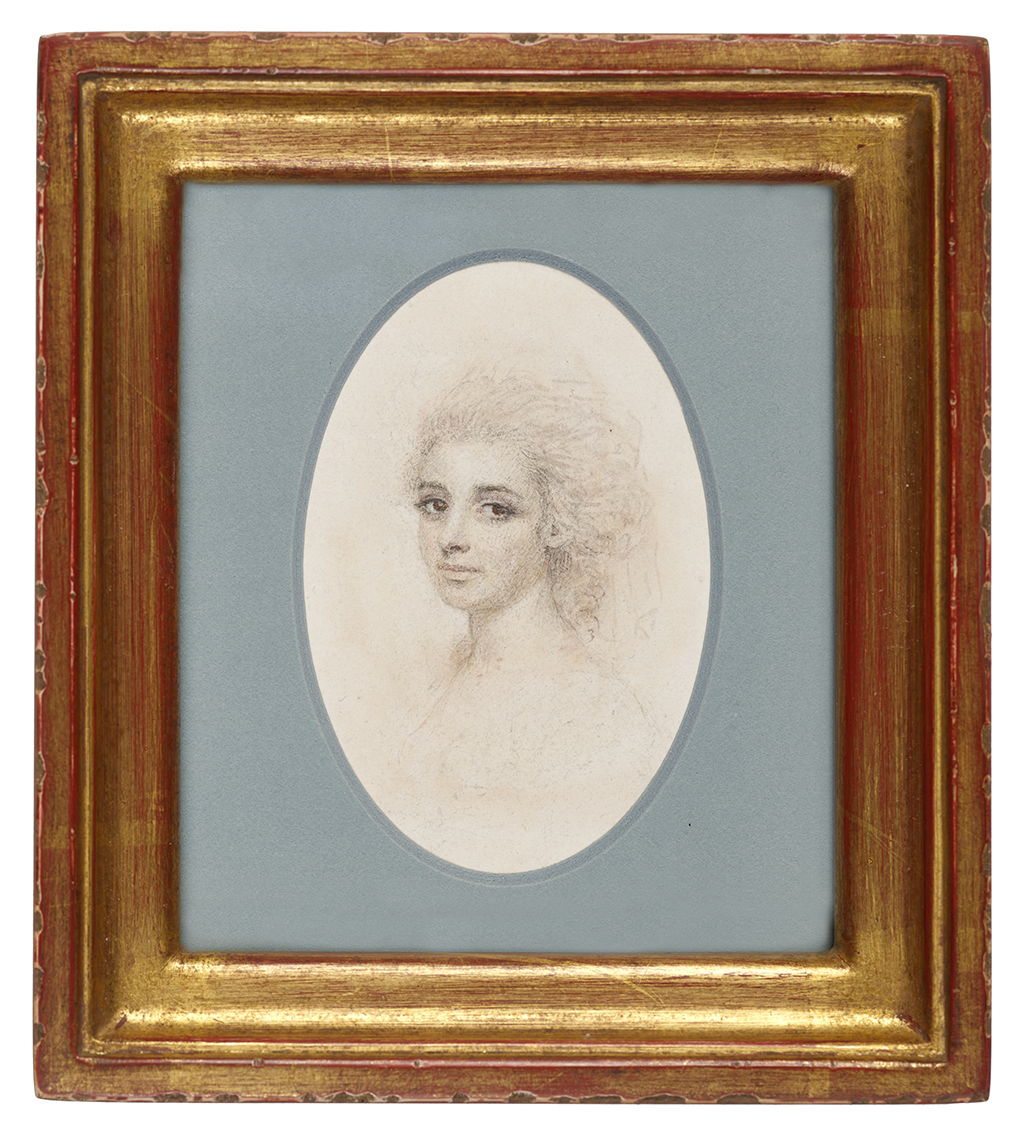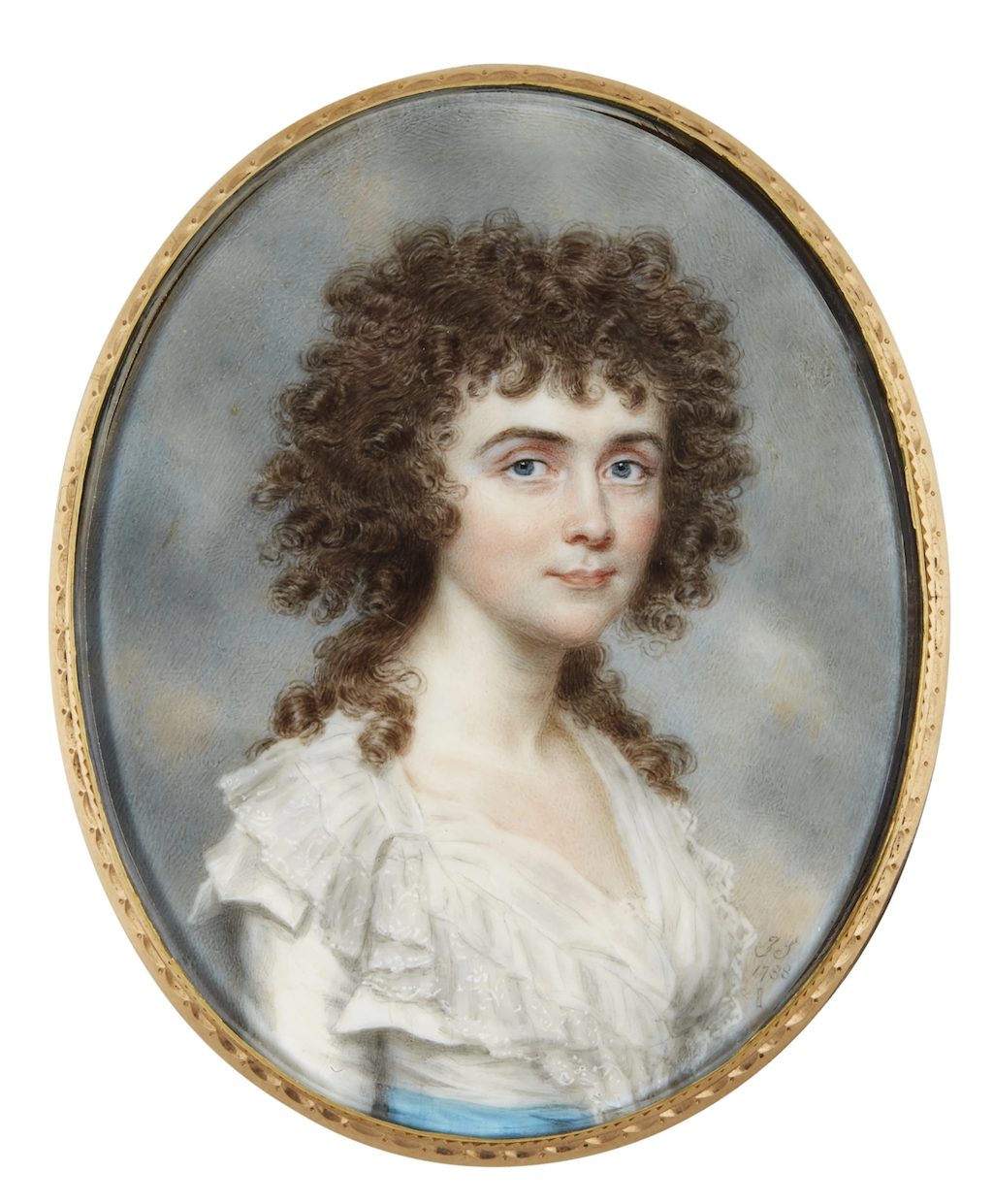Citation
Chicago:
Aimee Marcereau DeGalan, “John Smart, Portrait of a Woman, 1786,” catalogue entry in Aimee Marcereau DeGalan, Blythe Sobol, and Maggie Keenan, The Starr Collection of Portrait Miniatures, 1500–1850: The Collections of the Nelson-Atkins Museum of Art, vol. 4, ed. Aimee Marcereau DeGalan (Kansas City, MO: Nelson-Atkins Museum of Art, 2025), https://doi.org/10.37764/8322.5.1576.
MLA:
Marcereau DeGalan, Aimee. “John Smart, Portrait of a Woman, 1786,” catalogue entry. Aimee Marcereau DeGalan, Blythe Sobol, and Maggie Keenan. The Starr Collection of Portrait Miniatures, 1500–1850: The Collections of the Nelson-Atkins Museum of Art, edited by Aimee Marcereau DeGalan, vol. 4, Nelson-Atkins Museum of Art, 2025. doi: 10.37764/8322.5.1576.
Artist's Biography
See the artist’s biography in volume 4.
Catalogue Entry

This miniature and its related drawing (Fig. 1.
F58-60/145) entered the collection as portraits of “Mrs. Benj.
Edmundstone,” according to the Starr family inventory
sheets.1Photocopies of these inventory sheets are in the
NAMA registration files.
The identification of the sitter is partially, or
perhaps entirely, based on another portrait by John
Smart of a young woman believed to be Charlotte Anne
Edmonstone (1777–1838), née Freill, painted in 1788
before her 1803 marriage in Calcutta, India, to Neil
Benjamin Edmonstone, civil servant and director of the
Honourable East India Company (HEIC): A
British joint-stock company founded in 1600 to
trade in the Indian Ocean region. The company
accounted for half the world’s trade from the
1750s to the early 1800s, including items such as
cotton, silk, opium, and spices. It later expanded
to control large parts of the Indian subcontinent
by exercising military and administrative
power..2The most likely candidate for “Benjamin
Edmonstone” is an individual named Neil Benjamin
Edmonstone (1765–1841). For the union of Neil
Benjamin Ednonstone and Charlotte Freill, see
Charles Mosley, ed., Burke’s Peerage, Baronetage, and Knightage, 107th ed. (Wilmington, DE: Burke’s Peerage
[Genealogical Books]), 2003), 1:1274. The Smart
miniature came out of the collection of Dr. Erika
Pohl-Ströher and was formerly in the celebrated
collection of Baron Max von Goldschmidt-Rothschild
(1843–1940). See Sotheby’s, London, “The
Pohl-Ströher Collection of Portrait Miniatures,
Part I,” December 6, 2018, lot 68,
https://www.sothebys.com

Further research reveals that Freill was Edmonstone’s second wife, leaving open the possibility that this portrait may depict his first wife. However, period records reveal that Edmonstone’s first wife, though unnamed, was described as a bibi, a term derived from begum or begam, meaning “wife” in Hindi or Urdu.4Neil Benjamin Edmonstone arrived in Calcutta as an HEIC writer in 1783. He began a family with an unknown bibi in the 1790s and had three sons and a daughter, born in the late 1790s and early 1800s. They reportedly were given the surname Elmore and sent to England to be fostered by the sister of a friend in the HEIC; see Mildred Archer, India and British Portraiture, 1770–1825 (London: Sotheby Parke Bernet, 1979), 379, 513. Edmonstone continued to provide for his Indian family separately from his European one; see Christopher Alan Bayly, Empire and Information: Intelligence Gathering and Social Communication in India, 1780–1870 (Cambridge: Cambridge University Press, 1996), 91n146. See also Dorota Kamińska-Jones, “England’s Affair with India: Bibi in the Art of European Artists in the Second Half of the Eighteenth Century,” in The Artistic Traditions of Non-European Cultures, ed. Bogna Łakomska (Warsaw: Polish Institute of World Art Studies, 2012), 2:98–99. In eighteenth-century India, bibi referred to the Indian female companions of British men.5In the nineteenth century the word “bibi” acquired a pejorative meaning, and it began to be used as a synonym for “mistress” to describe any Indian woman in a relationship with a British man; see Hermione de Almeida and George H. Gilpin, Indian Renaissance: British Romantic Art and the Prospects of India (Aldershot: Ashgate, 2005), 82, cited in Kamińska-Jones, “England’s Affair with India,” 99. See also Shuchi Kapila, “Of Bibis and Begums: Company Affairs in Colonial India,” in Educating Seeta: The Anglo-Indian Family Romance and the Poetics of Indirect Rule (Columbus: Ohio State University Press, 2010), 23–32. Given the ivory pallor of the present sitter, it is highly unlikely that she was of Indian descent.6According to scholar Durba Gosh, “It is estimated that in the years 1780–1785 in Calcutta, about 50 percent of men were living in mixed informal relationships, and only 7 percent of them were legally married”; Durba Ghosh, Sex and the Family in Colonial India: The Making of Empire (Cambridge: Cambridge University Press, 2006), 39, cited in Kamińska-Jones, “England’s Affair with India,” 99.
Whoever the sitter may be, Smart depicts this young woman with large, dark brown eyes and powdered hair piled high—likely bolstered by false locks—and topped with a small white mob cap: A round, gathered or pleated cloth (usually linen) bonnet to cover the hair, frequently with a ruffled brim and ribbon band. lined in pink, with a veil attached. The preparatory sketch shows the faint outline of the veil over the sitter’s left shoulder, which is clearly visible in the finished ivory: The hard white substance originating from elephant, walrus, or narwhal tusks, often used as the support for portrait miniatures.. Notably, both the sketch and the finished ivory depict two moles on the sitter’s collarbone marking her otherwise alabaster skin. She wears a white Indian cotton gown7For more on the cotton industry in India and its economic impact on England, see Stephen Broadberry and Bishnupriya Gupta, “Lancashire, India, and Shifting Competitive Advantage in Cotton Textiles, 1700–1850: The Neglected Role of Factor Prices,” Economic History Review 62, no. 2 (May 2009): 279–305. with an open ruffled collar, trimmed in blue, similar to the one worn by Charlotte Porcher, who may have been dressed for her wedding to HEIC’s Josias Du Pré Porcher when she was painted by John Smart in 1787.
In the late eighteenth century, HEIC stations were often described as “marriage bazaars,” where Englishwomen were capitalized on like other merchandise.8John C. Leffel discusses this in his article “Empire, Race, and the Debate Over the Indian Marriage Market in Elizabeth Hamilton’s Memoirs of Modern Philosophers (1800),” Eighteenth-Century Fiction 26, no. 3 (Spring 2014): 427–54. These women were frequently seen as complicit in their own commodification. On returning to Britain, they often faced ridicule and social ostracism. While the fate of the woman in this miniature and its related sketch remains unknown, she was likely a young bride, much like Charlotte Anne Edmonstone, who became a company wife and raised a large family.
Notes
-
Photocopies of these inventory sheets are in the NAMA registration files.
-
The most likely candidate for “Benjamin Edmonstone” is an individual named Neil Benjamin Edmonstone (1765–1841). For the union of Neil Benjamin Ednonstone and Charlotte Freill, see Charles Mosley, ed., Burke’s Peerage, Baronetage, and Knightage, 107th ed. (Wilmington, DE: Burke’s Peerage [Genealogical Books]), 2003), 1:1274. The Smart miniature came out of the collection of Dr. Erika Pohl-Ströher and was formerly in the celebrated collection of Baron Max von Goldschmidt-Rothschild (1843–1940). See Sotheby’s, London, “The Pohl-Ströher Collection of Portrait Miniatures, Part I,” December 6, 2018, lot 68, https://www.sothebys.com/en/auctions/ecatalogue/2018/pohl-stroher-collection-l18322/lot.68.html.
-
Indeed, Charlotte Edmonstone was in India by at least 1803 for her marriage there to Neil Benjamin Edmonstone. She commissioned a portrait by Smart’s near-contemporary George Chinnery (1774–1852) of her two eldest girls with Edmonstone. See George Chinnery, Charlotte (1805–1878) and Henrietta Edmonstone (1806–1808), ca. 1810, pencil and watercolor on paper, 8 1/2 x 6 in. (21.6 x 15.2 cm), Christie’s, London July 13, 2006, (sale 7034), lot 26, https://www.christies.com/lot/lot-george-chinnery-1774-1852-charlotte-and-henrietta-4750652.
-
Neil Benjamin Edmonstone arrived in Calcutta as an HEIC writer in 1783. He began a family with an unknown bibi in the 1790s and had three sons and a daughter, born in the late 1790s and early 1800s. They reportedly were given the surname Elmore and sent to England to be fostered by the sister of a friend in the HEIC; see Mildred Archer, India and British Portraiture, 1770–1825 (London: Sotheby Parke Bernet, 1979), 379, 513. Edmonstone continued to provide for his Indian family separately from his European one; see Christopher Alan Bayly, Empire and Information: Intelligence Gathering and Social Communication in India, 1780–1870 (Cambridge: Cambridge University Press, 1996), 91n146. See also Dorota Kamińska-Jones, “England’s Affair with India: Bibi in the Art of European Artists in the Second Half of the Eighteenth Century,” in The Artistic Traditions of Non-European Cultures, ed. Bogna Łakomska (Warsaw: Polish Institute of World Art Studies, 2012), 2:98–99.
-
In the nineteenth century the word “bibi” acquired a pejorative meaning, and it began to be used as a synonym for “mistress” to describe any Indian woman in a relationship with a British man; see Hermione de Almeida and George H. Gilpin, Indian Renaissance: British Romantic Art and the Prospects of India (Aldershot: Ashgate, 2005), 82, cited in Kamińska-Jones, “England’s Affair with India,” 99. See also Shuchi Kapila, “Of Bibis and Begums: Company Affairs in Colonial India,” in Educating Seeta: The Anglo-Indian Family Romance and the Poetics of Indirect Rule (Columbus: Ohio State University Press, 2010), 23–32.
-
According to scholar Durba Gosh, “It is estimated that in the years 1780–1785 in Calcutta, about 50 percent of men were living in mixed informal relationships, and only 7 percent of them were legally married”; Durba Ghosh, Sex and the Family in Colonial India: The Making of Empire (Cambridge: Cambridge University Press, 2006), 39, cited in Kamińska-Jones, “England’s Affair with India,” 99.
-
For more on the cotton industry in India and its economic impact on England, see Stephen Broadberry and Bishnupriya Gupta, “Lancashire, India, and Shifting Competitive Advantage in Cotton Textiles, 1700–1850: The Neglected Role of Factor Prices,” Economic History Review 62, no. 2 (May 2009): 279–305.
-
John C. Leffel discusses this in his article “Empire, Race, and the Debate Over the Indian Marriage Market in Elizabeth Hamilton’s Memoirs of Modern Philosophers (1800),” Eighteenth-Century Fiction 26, no. 3 (Spring 2014): 427–54.
Provenance
Mr. John W. (1905–2000) and Mrs. Martha Jane (1906–2011) Starr, Kansas City, MO, by 1958–1965;
Their gift to the Nelson-Atkins Museum of Art, Kansas City, MO, 1965.
Exhibitions
John Smart—Miniaturist: 1741/2–1811, The Nelson-Atkins Museum of Art, Kansas City, MO, December 9, 1965–January 2, 1966, no cat., as Lady.
The Starr Foundation Collection of Miniatures, The Royal Ontario Museum, Toronto, December 8, 1972–January 14, 1973, no cat., no. 115, as Unknown Lady.
John Smart: Virtuoso in Miniature, The Nelson-Atkins Museum of Art, Kansas City, MO, December 21, 2024–January 4, 2026, no cat., as Portrait of a Woman.
References
“The Starr Collection of Miniatures: European and American,” Bulletin (The Nelson Gallery and Atkins Museum) 1, no. 2 (December 1958): 16, (repro.), as Portrait of a Lady and formerly as F58-60/127.
Ross E. Taggart, ed., Handbook of the Collections in the William Rockhill Nelson Gallery of Art and Mary Atkins Museum of Fine Arts, 4th ed. (Kansas City, MO: William Rockhill Nelson Gallery of Art and Mary Atkins Museum of Fine Arts, 1959), 136, 265, (repro.), as Portrait of a Lady and formerly as F58-60/127.
Ross E. Taggart, The Starr Collection of Miniatures in the William Rockhill Nelson Gallery (Kansas City, MO: Nelson Gallery-Atkins Museum, 1971), no. 115, p. 42, (repro.), as Unknown Lady.
Ross E. Taggart and George L. McKenna, eds., Handbook of the Collections in The William Rockhill Nelson Gallery of Art and Mary Atkins Museum of Fine Arts, Kansas City, Missouri, vol. 1, Art of the Occident, 5th ed. (Kansas City, MO: William Rockhill Nelson Gallery of Art and Mary Atkins Museum of Fine Arts, 1973), 149, (repro.), as Portrait of a Lady and formerly as F58-60/127.
If you have additional information on this object, please tell us more.